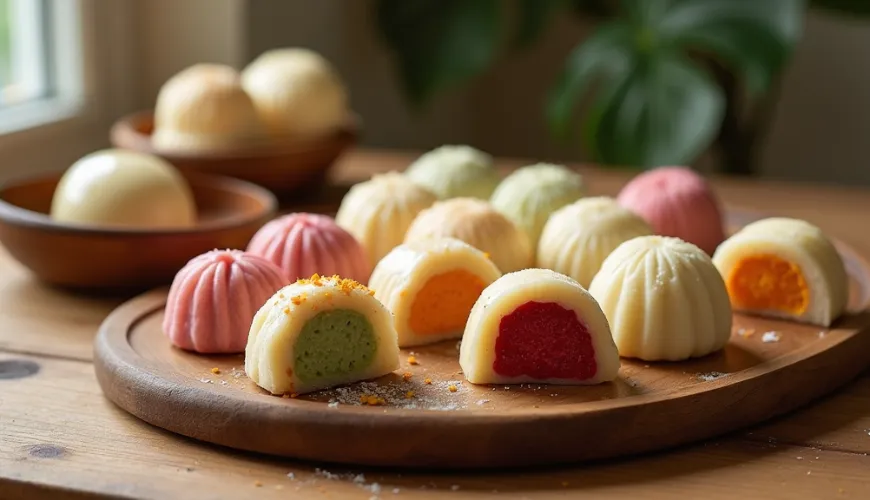
Mochi recipe that will delight you with its simplicity and deliciousness

Mochi as a Sweet Delight from Japan You'll Love at Home
While European desserts often revolve around butter, flour, and sugar, Japanese cuisine offers a completely different philosophy of sweets—delicate, minimalist, and often surprising. One of the most iconic Japanese desserts is mochi, a chewy rice cake with an irresistible texture and numerous variations. And the best part? With a simple method, you can prepare homemade mochi right in your kitchen—no need to travel all the way to Kyoto.
What is Mochi and Why Has It Captivated the World?
Mochi is a traditional Japanese dish made from a special sticky rice called "mochigome," which is cooked and then pounded into a smooth, elastic mass. The result is a texture that modern gourmets describe as "chewy," gently sweet, and utterly unique. For Japanese, mochi is primarily associated with the New Year, when a ritual called "mochitsuki" takes place, involving the traditional preparation of mochi using wooden mallets. Today, mochi is also produced using more modern methods, not only in Japan—its popularity has soared in the West over the past decade.
One of the main advantages of mochi is its versatility. It can be filled with sweet red bean paste (anko), coated in soy powder (kinako), filled with ice cream, or even savory—with soy sauce or seaweed, for example. The evolving culinary world has also brought vegan and gluten-free versions, making it a dessert for almost everyone.
The Key to Perfect Mochi? The Right Ingredients and Patience
If you embark on a mochi recipe at home, you'll find that only a few basic ingredients are needed. However, as is often the case, a seemingly simple recipe can hide unexpected challenges. Traditional mochi is made from the aforementioned mochigome rice, which must be soaked for several hours, cooked, and then manually pounded. This process, while authentic, is nearly impossible in a home setting. Fortunately, there is a modern alternative: mochiko rice flour, which reduces the entire process to just half an hour.
Here is a basic homemade microwave mochi recipe that even beginners can handle:
Simple Microwave Mochi Recipe
Ingredients:
- 1 cup mochiko rice flour (available in specialty stores or online)
- 3/4 cup water
- 1/4 cup sugar
- Cornstarch or potato starch for dusting
Instructions:
- Mix mochiko, water, and sugar in a microwave-safe bowl. Stir until smooth with no lumps.
- Cover the bowl with plastic wrap and microwave on high for 1 minute.
- Stir and heat again in 30-second intervals, for a total of about 2 to 3 minutes. The dough should be shiny and elastic.
- Dust a work surface (or tray) with starch, transfer the dough onto it, and let it cool slightly.
- Divide the dough into small pieces and fill as desired—with anko paste, strawberries, or vegan ice cream, for example.
Tip: Shaping mochi is an art in itself. To prevent the dough from sticking to your hands, use starch and work quickly. Store the finished mochi in a sealed container, ideally in the fridge, and consume within two days.
Inspiration from Japan - Various Variations and Flavors
Japanese creativity knows no bounds, and this holds true for mochi as well. Traditional versions are filled with sweet red bean paste, but modern bakers and food bloggers worldwide are experimenting with flavors like matcha, coconut, mango, or black sesame. The so-called Ichigo Daifuku, where a whole strawberry is wrapped in mochi with a bit of sweet paste, has also become very popular—creating a dessert that is visually striking and tastefully harmonious.
An interesting example of blending tradition and modernity is a Tokyo café that started offering vegan mochi versions with tofu cream and fruit purées—and today it has lines out the door. This new approach to traditional foods offers hope that mochi will not remain just an exotic specialty but will become a common part of healthier eating here as well.
Mochi as Part of a Healthy Lifestyle?
You might be wondering: is a sweet like mochi really healthy? Compared to traditional butter and white flour desserts, mochi has several advantages. It is naturally gluten-free, which is appreciated by people with gluten intolerance, and due to its satisfying character, a smaller amount is sufficient. Moreover, if you use minimally processed ingredients, such as natural sugar or fruit fillings, mochi can be a pleasant addition to a balanced diet.
Interestingly, the original philosophy of Japanese desserts is not about excessive sweetness but about the balance of flavors and textures. Many Japanese sweets are not nearly as sweet as we are used to in Europe—and this makes them attractive to those seeking an alternative to overly sweetened cakes.
How Does Mochi Fit into Homes with Ecological and Ethical Values?
From a sustainability perspective, mochi is an excellent example of how to prepare a delicious dessert with minimal waste. Most ingredients have a long shelf life, making them easy to store and preventing waste. If you choose organic rice flour, ecological sugar, and seasonal fruit, you create a dessert with a minimal ecological footprint.
Moreover, you can prepare mochi entirely vegan—whether you opt for classic anko, coconut filling, or a purely fruit version. This makes it accessible to those trying to reduce animal products without compromising on taste expectations.
Mochi as a Ritual and Fun
Maybe you've been looking for a fun way to spend time with children or friends, and traditional baking seemed too mundane. Mochi might just be the perfect idea. Its preparation is creative, tactile, and literally "hands-on"—whether you're shaping balls, trying new fillings, or laughing at attempts to achieve the perfect shape.
One mother from Zlín described how her children fell in love with mochi during a summer camp, where they tried making it with a leader from Japan. "Since then, we make it almost every month. The children prepare their own mochi with fruit, and I know exactly what they're eating," she adds. This demonstrates that mochi is not just about taste—it's also about spending quality time together.
Where to Get Ingredients for Mochi?
If you're unsure where to start with your own mochi recipe attempt, don't despair. Specialty health food stores like Ferwer or online shops with Asian foods often offer everything you need: mochiko rice flour, ecological starch, vegan pastes, or organic fruit. The advantage is that most ingredients can also be used for other dishes—for example, mochiko is suitable for making Japanese dumplings or pancakes.
And if you're unsure where to start, try the basic version with anko and fruit—these ingredients are readily available and still create an authentic taste experience.
Mochi is more than just a dessert. It is a gateway into culture, an opportunity for creativity, a way to return to the simplicity and joy of homemade food preparation. Whether you're looking for a healthier alternative to classic sweets, interested in Japanese cuisine, or just want to try something new—mochi is among those recipes that will capture you and never let go.

